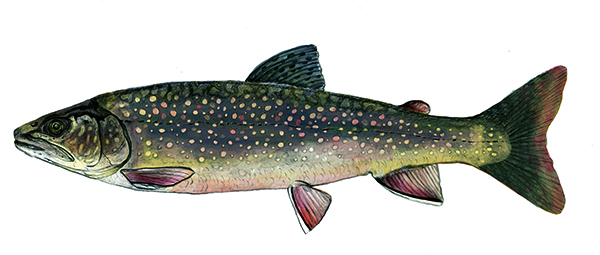Home → Fish & Wildlife → Fisheries → Species Information → Splake
Splake

Common Name: Splake (from speckled trout and lake trout)
Other Names: Wendigo
Scientific Name: Salvelinus namaycush X Salvelinus fontinalis
Origin: Hatchery Hybrid
Adult Size: In Maine, splake typically range in size from 10 to 18 inches. Splake grow at a faster rate than either of its parental species. They can attain lengths of 18 inches in just 2 years after stocking. Splake over 10 pounds have been caught.
Identification: Splake and brook trout have very similar coloration patterns, making it very difficult for the untrained eye to distinguish between the two species. Splake tend to have a slight fork in the tail, a trait passed down from its lake trout parent, while brook trout tend to have no fork or "square" tails.
Splake are a hybrid trout resulting from the cross of brook trout and lake trout.
Splake have been culturally produced since the 1870's.
This hybrid trout is genetically stable and capable of reproducing. However, splake reproduction has never been documented outside of the hatchery environment.
Splake are commonly stocked across the northern United States and throughout Canada for the purpose of providing fishing opportunity.
In 1958, splake were stocked in Long Pond in T10 SD, Washington County. This was the first stocking in Maine. It was part of a comparative study between brook trout, rainbow trout, landlocked salmon, and splake.
In 1990, the Department of Inland Fisheries and Wildlife began a pilot program to determine if splake could provide acceptable fisheries in waters where stocked brook trout had failed.
This study determined:
- Splake grew at a faster rate than stocked brook trout.
- Splake survived to older ages than stocked brook trout.
- Splake fed on other fish species, such as white perch and yellow perch, that typically out-compete brook trout.
In one study water, stocked brook trout rarely survived beyond age 1 and returns to the anglers were in the 2-8% range. In the same water, splake survived to age 4, providing fish in the 16-18 inch range. The estimated splake returns to anglers, during ice fishing only, were as high as 78%.
Nearly all of Maine's hatchery fish including brook trout, landlocked salmon, lake trout, splake, and brown trout are stocked for the sole purpose of providing angling opportunity. These fish are stocked in waters where there is insufficient spawning habitat. Very few fish are stocked for the purpose of creating wild populations.
Maine currently has approximately 53 waters managed primarily for splake. Fourteen of these waters are in the General Management category, 29 are in the Quality Management category, and 10 are in the Trophy Management category.
Splake are also stocked in conjunction with hatchery brook trout in some waters to provide an occasional larger fish.
In 2001, the ME DIF&W stocked just over 1.2 million fish. The total number of splake stocked was around 90,000 (7.5%).
This hybrid trout is not stocked in waters with significant wild brook trout fisheries. In one case, splake are stocked in a reclaimed pond in which brook trout have become self-sustaining. Splake are stocked in an effort to reduce the number of illegally introduced smelts. Since the introduction of smelts the population of brook trout has been declining.
This hybrid trout is easy to catch and provides excellent winter fishing opportunity. Over 90% of the total acreage of waters managed for splake is open to ice fishing.
In the winter, splake can be found in most any location. During the spring and fall, they can be caught with light tackle near the surface, even on flies. In the summer, they generally go deep, preferring water less that 60ºF.
Splake feed primarily on smelts, white perch, yellow perch, and minnows. They rarely feed on other coldwater gamefish.
This hatchery fish also provides expanded fall fishing opportunities in many lakes and ponds around the State.
The Maine State Record splake was caught in Basin Pond by Dan Paquette. It weighed 10 lbs. 3 oz. The world record splake was caught in Ontario and weighed 20 lbs. 11oz.
Most importantly, this hybrid trout is capable of creating quality fisheries in waters where other hatchery species have not been successful. This creates additional fishing opportunity for Maine anglers.